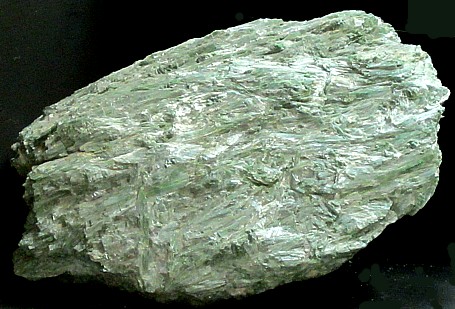|
.
Actinolite Mineral Facts:
Chemical Formula:
Ca2(Mg,Fe)5Si8022(OH)2
An
amphibole group silicate of calcium, magnesium and iron.
Colors:
Pale green to dark green, gray.
Its streak is a pale
shade of green. Color deepens with increase in the amount of iron
present.
Hardness:
5 to 6
Density: 3
to 3.2
Cleavage:
Perfect prismatic cleavage
as it is in all the amphiboles.
Crystallography: Monoclinic
Actinolite is nearly always in long, slender
acicular crystals without terminations.
Luster:.
Vitreous to resinous
luster. It is translucent to opaque.
Optics:
(Refractive Index):
=
a= 1.6116, b = 1.6270; y = 1.6387
|

Actinolite |
|
Composition,
Structure and Associated Minerals:
Actinolite commonly occurs in the crystalline schists, being often the chief
constituent of green-colored hornblende-schists and greenstones. Frequently
the amphibole of such rocks has had its origin in the pyroxene contained in
the igneous rock from which the metamorphic type has been derived. The name
actinolite
comes from two Greek words meaning a ray and stone, in allusion to its
frequently somewhat radiated
structure. Actinolite comprises the glassy and fibrous varieties of
amphibole. Generally occurs in long, slender, glassy, prisms of greenish
color. Actinolite forms a full
substitution series with the common calcium and magnesium mineral tremolite,
Ca2Mg5Si8O22(OH)2.
Magnesium and iron can be freely exchanged in the actinolite crystal
structure. Like tremolite, the fiberous form of actinolite is regulated as
asbestos.
Identification
and Diagnostics
Before the
blowpipe, all the members of the amphibole group fuse to a glass which is
colorless, green or black, according to the quantity of iron present. The
varieties rich in iron are attacked by acids. Both
actinolite
and tremolite
melt in the blowpipe flame,
the fusing temperature for tremolite being about 1290 and for actinolite
about 1150. Actinolite gives positive tests for iron, magnesium and calcium.
Told from pyroxene by its better prismatic cleavage, by the difference in
the prismatic angle and by the characteristic presence on the crystals of
the low clinodome. Pleochroism is strong in all the colored varieties in
green and yellowish green tones in the green varieties, and brown and
yellowish brown tints in the brown varieties. |
|
|
Occurrence,
Localities and Origins:
The mineral
occurs in many locations, but notable localities for the occurrence of
actinolite include Greiner, Zillerthal, Tyrol; hornblende from Bilin,
Bohemia; Monte Somma, Italy. Actinolite frequently comes fibrous, and is the
material to which the name asbestos was originally given. It has been found
in the metamorphic rocks in various states along the Appalachian Mountains.
Nephrite jade is a tough, compact variety of actinolite which supplies
much of the material known as jade (see also under jadeite). A famous
locality for its occurrence for this gem material is in the Kuen Lun
Mountains, on the southern border of Turkestan. This form of jade supplies
much of the commercial material used in gem applications.
Nephrite occurs among metamorphosed rocks, especially among hornblende-schists
and serpentines that have
suffered from intense metamorphism. It has been found in various European
localities, but the chief sources of the stone are New Zealand, the Fraser
River area and many other locations in British Columbia, and several
locations in the US, including Alaska and near Monterrey in California.
Return to the
Mineral Collectors Information Page
|


